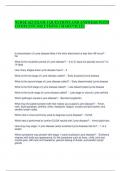Exam (elaborations)
NURSE 623 EXAM 1 QUESTIONS AND ANSWERS WITH COMPLETE SOLUTIONS [ MARYVILLE]
- Course
- Institution
NURSE 623 EXAM 1 QUESTIONS AND ANSWERS WITH COMPLETE SOLUTIONS [ MARYVILLE] Is transmission of Lyme disease likely if the thick attachment is less than 48 hours? - No What is the incubation period of Lyme disease? - 3 to 31 days but typically around 7 to 14 days How many st...
[Show more]



